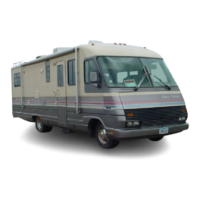FILLING
THE
REMOVABLE LPG
TANKS
Removable
LPG
tanks should always be removed from
the
storage
compartment
while being filled.
Take
the
tank
to
an
LPG
supplier
or
to
a service
station
which
sells
LPG. Keep
the
tank
at
least 25 feet from
the
veh-
icle while it
is
being filled. Do
not
smoke
or
expose to-
open
flames in or near a
fill
ing
area.
BRASS FITTINGS.
IF
THE LEAK CANNOT
BE
LO-
CATED, TAKE THE UNIT
TO
AN
LPG SERVICEe
REPRESENTATIVE.
Keep
the
tank valve closed
and
turn
OF F all appliances
if
the
unit
is
not
being used. When
operating
LPG
appli·
ances, use only
one
tank
at
a
time
to
avoid
inadvertently
depleting
your
LPG
supply.
To
remove
the
tank,
first close
the
tank
valve,
then
dis- LPG APPLIANCES
connect
the
tank
from
the
supply
line_
NOTE:
In
removing
the
fittings, use
the
proper
size
Your
range
top
and
oven, furnace,
and
water
heater
op-
wrench
to
avoid damaging
the
fitting.
Turn
erate
on LPG, while
your
refrigerator
can
operate
on
the
fitting clockwise
to
loosen (reverse thread). either
LPG
or electricity. Warranty
certificate
registrat-
Remove restraining clamps
by
lifting
the
loop release
lever from
the
strap
and opening
the
strap_ With
the
line
disconnected and
the
strap
loose, remove
the
tank
by
lifting it
out~
WARNING
AN
EMPTY TANK WEIGHS APPROXIMATELY
20
POUNDS OR MORE: HANDLE IT
CAREFULLY
TO
AVOID DAMAGE OR INJURY.
To
replace
the
LPG
tank,
reverse
the
above procedure.
Be
sure
to
use a counter-clockwise
or
reverse-thread mo-
tion
to
tighten
the
connector.
Be
sure
that
the
male fit-
ting
is
properly
aligned with
the
female receptacle
to
a-
void damaging
the
threads.
Be
sure
that
connections
are
tight,
but
avoid excessive force.
FILLING THE CHASSIS-MOUNTED LPG TANK (OP-
TIONAL
ON
j::
MODEL ONL Y)
If
you
have an optional chassis-mounted storage
tank,
drive
the
vehicle
to
an
LPG
supplier
or
one
of
the
ser-
vice stations which sell
LPG
to
have
the
tank
filled.
Look
under
Gas, Liquified Petroleum, Bottled and Bulk,
in
your
classified
directory
or
refer
to
the
service direc-
tory
available
at
your
dealer. For additional informa-
tion, refer
to
instructions
for
your
gas appliances pro-
vided
in
your
Owner's Information Kit.
LPG
SYSTEM LEAK CHECKS
For
your
safety,
check
for
leaks
in
your
gas system each
time
the
tank
is
filled
or
before
each trip. Always check
the
system
any
time
the
odor
of
garlic
is
detected.
To
perform a leak check,
open
the
tank
valve
and
spread a
non-ammoniated
type
(i.e. castile, etc.) soap-bubble
solution over all connections. Escaping gas will create
visible bubbles
to
show
the
location
of
any
leak.
WARNING
tion
cards, .service instructions, and
other
information
are inCluded
in
the
Owner's
Information
Kit
provided
with
the
motor
home. All
information
relating
to
your
appliance
should
be
kept
readily available
for
easy
reference.
NOTE:
Be
sure
to
fill
out
and
mail
the
warranty
reg-
istration cards
on
all appliances as
soon
as
possible_
It
is
important
to
carefully follow all
operating
and
lighting instructions provided on
or
near
each
appliance
(or
in
your
Owner's
Information
Kit). For
the
initial
lighting
of
an LPG appliance,
it
may
be
necessary
to
purge
the
LP'G
supply line,
open
a
burner
or
a
pilot
valve
and
hold a flame near
the
burner. Allow
time
for
air
to
escape.
The
time
will vary
depending
on
the
dis-
tance
the
appliance
is
located from
the
LPG
tank.
After
several seconds,
the
gas
should
ignite
and
burn
steadily.
RANGE TOP AND OVEN
The
range
top
and
oven in
your
motor
home
are
pro-
vided with a vent
or
range
hood.
The
hood
has a
power
vent
fan. Always use
the
fan
when
using
the
oven
or
range
top
in
order
to
ensure
adequate
ventilation.
When
cooking for long periods
of
with
a large
number
of
peo-
ple
in
the
home,
it
may be desirable
to
open
a
window
or
a
roof
vent 'slightly
to
further
increase
ventilation
level.
CAUTION
DO
NOT
USE
OPEN FLAMES' SUCH
AS
THE
OVEN
OR
RANGE TOP, TO WARM THE LIVING
AREA
BE-
CAUSE GAS COMBUSTION CONSUMES
THE OXY-
GEN INSIDE THE HOME.
The
oven has a
pilot
light. Refer
to
information
on
the
appliance
or
from
the
manufacturer
for
instructions
on
use. When using
the
oven pilot,
note
that
the
type
of
heat-actuated ignition
control
used
for
the
main oven
burner
may result in a normal delay
of
a few
seconds,
after
the
oven
control
knob
is
turned
ON,
before
the
NEVER CHECK FOR LEAKS WITH
AN
OPEN main oven burner ignites. If
you
are
sure
the
pilot
is
FLAME.
DO
NOT CHECK COPPER PLUMBING burning, anticipate
approximately
five (5)
seconds
LINES FOR LEAKS USING AMMONIATED HOUSE- delay for
the
burner
to
ignite. If
it
doesn't
ignite
within
HOLD-TYPE DETERGENTS BECAUSE THESE CAN five (5) seconds,
turn
the
control
knob
OFF
and
check
CAUSE CRACKS TO FORM
ON
THE LINES AND
the
pilot
light
or
the
supply.
16

